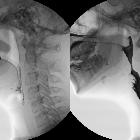larsen syndrome

Larsen
syndrome. There is chronic anterior and superior dislocation of the tibia with respect to femur, left knee joint worse than right.

Larsen
syndrome. There is chronic anterior and superior dislocation of the tibia with respect to femur with Genu recurvatum.
Larsen syndrome (LS) is an extremely rare disorder, often classified as a type of osteochondrodysplasia.
Epidemiology
The estimated incidence is thought to be at ~ 1 in 100,000 people. There may be an increased female predilection.
Clinical presentation
It is characterized by many features including:
- joint hypermobility
- multiple congenital dislocations (typically knees)
- characteristic facies
- brachycephaly
- cleft palate
- club feet
Pathology
Genetics
There can be significant genetic heterogeneity. It is usually inherited as an autosomal dominant fashion while some autosomal recessive forms have also been described. The autosomal dominant form of Larsen syndrome is thought to be due to mutations in a gene called LAR1, on the short arm of chromosome 3.
History and etymology
The condition was first described in a 1950 journal report by L. J. Larsen, et al.
Siehe auch:
- Skelettdysplasie
- Klumpfuß
- Gaumenspalte
- Brachyzephalie
- Angeborene Luxation
- Bumerang-Dysplasie
- Spondyloepimetaphysäre Dysplasie
- Oto-palato-digitales Syndrom Typ 1
- Frontometaphysäre Dysplasie
und weiter:

 Assoziationen und Differentialdiagnosen zu Larsen-Syndrom:
Assoziationen und Differentialdiagnosen zu Larsen-Syndrom:


